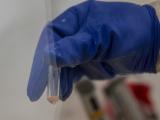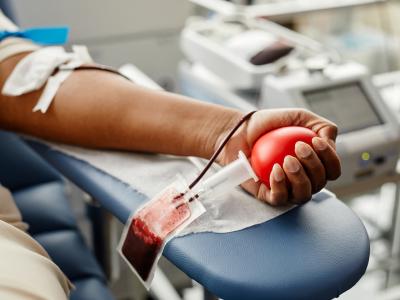Mar 7, 2002 (CIDRAP News) A committee of the Institute of Medicine (IOM) has concluded after 17 months of study that the existing anthrax vaccine is effective and "acceptably safe," but a new vaccine that requires fewer doses and that causes fewer reactions is needed.
"Although AVA [anthrax vaccine adsorbed] appears sufficiently effective and safe for use, it is far from optimal," states the summary of the report. "A new vaccine, developed by more modern principles of vaccinology, is urgently needed."
The vaccine requires six doses over 18 months, with annual boosters thereafter. "The current subcutaneous route of injection and the six-dose schedule appear to cause a higher incidence of local reactions than is seen with a reduced-dose vaccination schedule or with intramuscular administration," the summary states.
The committee called for a new vaccine that would require only two or three injections and provide protection within 30 days. Meanwhile, the Department of Defense (DoD) can continue to use the existing vaccine, but it should support research to improve the way the vaccine is administered and to develop an alternative, the committee said.
More than 500,000 US military personnel have received the anthrax vaccine. DoD launched a program in 1998 to vaccinate all service members, but the program was cut back in 2000 because of a shortage of the vaccine. The shortage resulted from difficulties that the vaccine manufacturer, BioPort Corporation in Lansing, Mich., had in obtaining federal approval of its production processes after a plant renovation. BioPort finally received Food and Drug Administration (FDA) approval in January 2002.
The vaccination program generated controversy when some service members complained that the shots caused chronic fatigue, memory loss, and other health problems. More than 400 military personnel refused the shots, according to the IOM. Some military personnel also suggested that the vaccine may have contributed to the Gulf War syndrome, since about 150,000 soldiers had received the shots during that war.
These concerns led Congress to order DoD to commission an independent study of the vaccine. In October 2000, the IOM set up the Committee to Assess the Safety and Efficacy of the Anthrax Vaccine. Besides assessing safety and efficacy, the committee was assigned to review how BioPort documented its production methods for the FDA and to identify gaps in research on the vaccine. The committee said it "elected to hear from all groups and individuals who had anything to contribute, whether data, concerns, or complaints." The panel was chaired by Brian L. Strom, director of the Center for Epidemiology and Biostatistics at the University of Pennsylvania School of Medicine in Philadelphia.
After reviewing the available evidence from human and animal studies, the committee concluded that AVA is effective against anthrax, including inhalational anthrax. Because the vaccine uses protective antigen (a protein that is essential to anthrax's toxicity) to generate an immune response, the vaccine "should be effective against anthrax toxicity from all known strains of anthrax bacteria, as well as against any strains that might be bioengineered by terrorists or others," the summary states. In addition, limited animal studies suggest that, when given in combination with antibiotics after exposure to anthrax, AVA may help prevent inhalational anthrax.
The committee called for research to correlate the levels of antibodies in humans who have been fully vaccinated with the levels of antibodies in animals that have been effectively immunized with the vaccine. That information could be used to test the efficacy of the existing vaccine and new vaccines. The panel also recommended more studies on the efficacy of postexposure vaccination in combination with antibotic treatment, with a goal of determining how long antibiotic treatment should continue.
On the basis of numerous epidemiologic studies and case reports, the committee found that AVA is "acceptably safe." Temporary injection-site reactions such as redness and swelling are "fairly common," and a smaller number of recipients have temporary systemic reactions such as fever and malaise, the summary report says. These reactions are about as common as reactions to other adult vaccines.
"The committee found no evidence that people face any increased risk of experiencing life-threatening or permanently disabling adverse events immediately after receiving AVA, when compared with the general population," the report says. Nor was there clear evidence of any long-term harm, though the data are limited.
Nonetheless, the committee called for efforts to improve how the vaccine is currently used and to detect any adverse health effects. "DoD should continue to support the efforts of the Centers for Disease Control and Prevention to study alternative routes and schedules for AVA injections," the summary says. In addition, DoD should improve its capacity to detect "later-onset health conditions" that might be associated with AVA or any other vaccine. In particular, DoD should use the Defense Medical Surveillance System, a database that includes data for service members' entire military careers, to test hypotheses about vaccine-related adverse events.
The committee said that in view of recent events, the military is likely to speed up its anthrax vaccination program, and the government is likely to expand vaccination to high-risk civilian groups. This increases the need for improvements in the way AVA is used, systematic monitoring for adverse reactions, and development of a better vaccine, the group said.
"An improved vaccine should cause neither severe local reactions (because they may create an unwarranted perception that a vaccine is dangerous even when the effects are transient) nor severe systemic reactions (as expected of all vaccines)," the summary states. "Among other characteristics, a new vaccine should require only two or three injections, elicit protection within 30 days that lasts for at least a year, and remain potent for a long period of time so that it can be stockpiled to ensure ample supplies when needed."
In an IOM news release, committee Chairman Strom commented, "The most prudent course of action is to develop a new vaccinegiven the nation's war against terrorism and the domestic attacks where anthrax was used as a deadly weapon. In the meantime, the current vaccine is sufficiently safe and effective to be useful."
Regarding vaccine manufacture, the report says the committee could not directly evaluate BioPort's production process and "did not find it necessary to second-guess the FDA's inspection and ultimate validation" of the process. But the panel reviewed the steps the company took to gain FDA approval and concluded that "AVA will be produced under strict controls according to current FDA requirements." This should result in greater consistency in the vaccine than was the case when the vaccine was first licensed (in 1970), the committee says. Nevertheless, the report recommends continued monitoring of the vaccine's immunogenicity, stability, and safety, as is required for all vaccines.

















